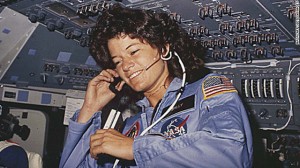Astronaut Sally Ride dead at 61
Space used to be a man’s world. Then came Sally Ride, who blazed a cosmic trail for U.S. women into orbit. With a pitch perfect name out of a pop song refrain, she joined the select club of American space heroes the public knew by heart – Shepard, Glenn, Armstrong and Aldrin.
Ride, the first American woman in orbit, died Monday at her home in the San Diego community of La Jolla at age 61. The cause was pancreatic cancer, an illness she had for 17 months, according to her company, Sally Ride Science.
Ride rode into space on the space shuttle Challenger on June 18, 1983, when she was 32. Since then, 42 other American women flew in space.
“Sally was a national hero and a powerful role model. She inspired generations of young girls to reach for the stars” – President Barack Obama said in a statement.
When shuttles started flying frequently with crews of six or seven, astronauts became plentiful and anonymous. Not Ride.
“People around the world still recognize her name as the first American woman in space, and she took that title seriously even after departing NASA” – Eileen Collins, the first female space shuttle commander, said in a statement. “She never sought media attention for herself, but rather focused on doing her normally outstanding job.”
Sally Ride, the first American woman to fly in space, died Monday after a 17-month battle with pancreatic cancer, her company said. She was 61.
“Sally lived her life to the fullest, with boundless energy, curiosity, intelligence, passion, commitment and love. Her integrity was absolute; her spirit was immeasurable; her approach to life was fearless” – read a statement on the website of Sally Ride Science, a company she started to help teach students – particularly young women and girls – about science, math and technology.
Ride flew into orbit aboard the Space Shuttle Challenger in 1983 to become America’s first woman in space. She took a second trip aboard the same shuttle one year later.
The first woman in space was Soviet cosmonaut Valentina Tereshkova, who orbited the Earth 48 times in 1963.
“As the first American woman to travel into space, Sally was a national hero and a powerful role model” – President Barack Obama said soon after news of her death broke. “She inspired generations of young girls to reach for the stars and later fought tirelessly to help them get there by advocating for a greater focus on science and math in our schools. Sally’s life showed us that there are no limits to what we can achieve, and I have no doubt that her legacy will endure for years to come.”
According to her official biography, by the time Ride decided to apply to become an astronaut, she had already received degrees in physics and English and was on her way to a Ph.D. in physics from Stanford University.
According to her NASA biography, Ride went back into space in October of 1984. She was assigned to another mission after that, but it was scrapped after the shuttle Challenger disaster in 1986.
Steve Inskeep spoke to Ride after the Columbia disaster in 2003. She said despite the tragedies humans would continue their exploration.
“Studying whether there’s life on Mars or studying how the universe began, there’s something magical about pushing back the frontiers of knowledge” – she said. “That’s something that is almost part of being human and I’m certain that will continue.”
Ride served on the presidential commission investigating the Challenger accident. After a stint as a professor of physics at the University of California, San Diego, Ride founded Sally Ride Science. As NASA puts it, the company allowed her to “pursue her long-time passion of motivating girls and young women to pursue careers in science, math and technology.”
Ride was born in Encino, Calif., on May 26, 1951. Karen O’Connor, who chronicled her early life in Sally Ride and the New Astronauts, described her as a “tomboy,” racing her father for the sports section of the newspaper when she was 5 years old.
Becoming an astronaut had a bit to do with luck. The same year she started job hunting, NASA opened up its space program to women.
“Sally Ride broke barriers with grace and professionalism – and literally changed the face of America’s space program” – NASA Administrator Charles Bolden said in a statement. “The nation has lost one of its finest leaders, teachers and explorers. Our thoughts and prayers are with Sally’s family and the many she inspired. She will be missed, but her star will always shine brightly.”
In an interview with NASA celebrating the 25th anniversary of her flight, Ride described the awesomeness of space.
“When the space shuttle’s engines cut off, and you’re finally in space, in orbit, weightless … I remember unstrapping from my seat, floating over to the window, and that’s when I got my first view of Earth. Just a spectacular view, and a chance to see our planet as a planet” – she said.
“I could see coral reefs off the coast of Australia. A huge storm swirling in the ocean. I could see an enormous dust storm building over northern Africa … just unbelievable sights.”
